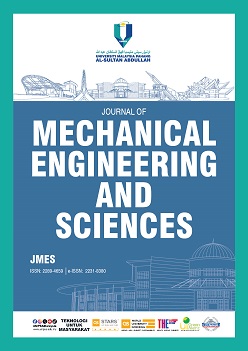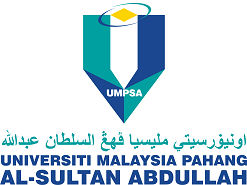Surface roughness prediction for CNC-turned C45 steel utilising adaptive neuro-fuzzy inference systems
DOI:
https://doi.org/10.15282/jmes.18.4.2024.1.0807Keywords:
Predicting model, Surface Roughness, Adaptive Neuro-fuzzy Inference System, Turning, C45 steelAbstract
The surface roughness, Ra of mechanical products is an important parameter commonly used to evaluate the surface quality of a part after machining. Therefore, developing accurate prediction models for surface roughness is essential for optimizing manufacturing processes without multiple and repetitive experiments, leading to significant savings in both cost and time. This study examines the impact of turning parameters, including cutting speed, V, feed rate, f, and depth of cut, d, on Ra and develops a predictive model for the turning of C45 steel. The Taguchi method and the analysis of variance (ANOVA) were used to design the experiments and analyze the effects of machining parameters on Ra. Additionally, a predictive model for Ra was developed using the Adaptive Neuro-Fuzzy Inference System (ANFIS), and the efficiency of this model was evaluated based on the coefficient of determination, R² and the Root Mean Square Error (RMSE). The results of the ANOVA analysis showed that all three cutting parameters had significant effects on Ra. However, the f parameter had the most significant influence on Ra at 90.35%, followed by V and d at 1.9% and 3.24%, respectively. The developed ANFIS prediction model with Gaussian membership functions for Ra achieved R² of 0.989 for training and 0.963 for testing and RMSE of 0.112 and 0.223, respectively. These results indicate that the ANFIS model can predict Ra relatively accurately based on cutting parameters. Thus, the results of this research can be useful in C45 steel turning operations, which further enables assessment and improvement of cutting parameters to reduce Ra, thereby improving product quality.
References
[1] A. M. Khorasani, M. R. S. Yazdi, M. S. Safizadeh, “Analysis of machining parameters effects on surface roughness: A review,” International Journal of Computational Materials Science and Surface Engineering, vol. 5, no. 1, pp. 68-84, 2012.
[2] P. Benardos, G.-C. Vosniakos, “Predicting surface roughness in machining: A review,” International Journal of Machine Tools and Manufacture, vol. 43, no. 8, pp. 833-844, 2003.
[3] M. Soori, M. Asmael, “A review of the recent development in machining parameter optimization,” Jordan Journal of Mechanical and Industrial Engineering, vol. 16, no. 2, pp. 205-223, 2022.
[4] A. Ghani, I. Choudhury, “Study of tool life, surface roughness and vibration in machining nodular cast iron with ceramic tool,” Journal of Materials Processing Technology, vol. 127, no. 1, pp. 17-22, 2002.
[5] T. Misaka, J. Herwan, O. Ryabov, S. Kano, H. Sawada, N. Kasashima, Y. Furukawa, “Prediction of surface roughness in CNC turning by model-assisted response surface method,” Precision Engineering, vol. 62, pp. 196-203, 2020.
[6] M. Ficko, D. Begic-Hajdarevic, M. Cohodar Husic, L. Berus, A. Cekic, S. Klancnik, “Prediction of surface roughness of an abrasive water jet cut using an artificial neural network,” Materials, vol. 14 no. 11, p. 3108, 2021.
[7] X. A. Vasanth, P. Paul, A. Varadarajan, “A neural network model to predict surface roughness during turning of hardened SS410 steel,” International Journal of System Assurance Engineering and Management, vol. 11, pp. 704-715, 2020.
[8] H. Dedeakayoğulları, A. Kaçal, K. Keser, “Modeling and prediction of surface roughness at the drilling of SLM-Ti6Al4V parts manufactured with pre-hole with optimized ANN and ANFIS,” Measurement, vol. 203, p. 112029, 2022.
[9] S. Djurović, D. Lazarević, B. Ćirković, M. Mišić, M. Ivković, B. Stojčetović, et al., “Modeling and prediction of surface roughness in hybrid manufacturing–milling after FDM using artificial neural networks,” Applied Sciences, vol. 14, no. 14, p. 5980, 2024.
[10] K. Łapa, K. Cpałka, L. Rutkowski, “New aspects of interpretability of fuzzy systems for nonlinear modeling,” Advances in Data Analysis with Computational Intelligence Methods, vol. 738, pp. 225-264, 2018.
[11] J. D. Olden, D. A. Jackson, “Illuminating the “black box”: A randomization approach for understanding variable contributions in artificial neural networks,” Ecological Modelling, vol. 154, no. 1-2, pp. 135-150, 2002.
[12] J. V. Tu, “Advantages and disadvantages of using artificial neural networks versus logistic regression for predicting medical outcomes,” Journal of Clinical Epidemiology, vol. 49, no. 11, pp. 1225-1231, 1996.
[13] A. Moral, C. Castiello, L. Magdalena, C. Mencar. Explainable Fuzzy Systems. 1st Ed. Switzerland: Springer Cham, 2021.
[14] N. Walia, H. Singh, A. Sharma, “ANFIS: Adaptive neuro-fuzzy inference system-A survey,” International Journal of Computer Applications, vol. 123, no. 13, pp. 32-28, 2015.
[15] H. Choi, S. H. Yoo, J. H. Jung, M. T. Lim, H. K. Lee, K. Ahn, “An ANFIS-based energy management inference algorithm with scheduling technique for legacy device,” in International Conference on Artificial Intelligence, Energy and Manufacturing Engineering, pp. 80-82, 2015.
[16] P. García, C. A. García, L. M. Fernández, F. Llorens, F. Jurado, “ANFIS-based control of a grid-connected hybrid system integrating renewable energies, hydrogen and batteries,” IEEE Transactions on industrial informatics, vol. 10, no. 2, pp. 1107-1117, 2013.
[17] M. Mehrasa, M. Babaie, A. Zafari, K. Al-Haddad, “Passivity ANFIS-based control for an intelligent compact multilevel converter,” IEEE Transactions on Industrial Informatics, vol. 17, no. 8, pp. 5141-5151, 2021.
[18] K. Baalamurugan, P. Singh, V. Ramalingam, “A novel approach for brain tumor detection by self-organizing map (SOM) using adaptive network based fuzzy inference system (ANFIS) for robotic systems,” International Journal of Intelligent Unmanned Systems, vol. 10, no. 1, pp. 98-116, 2022.
[19] H. Khan, S. Khatoon, P. Gaur, S. A. Khan, “Speed control comparison of wheeled mobile robot by ANFIS, Fuzzy and PID controllers,” International Journal of Information Technology, vol. 14, no. 4, pp. 1893-1899, 2022.
[20] Y. Yuan, “Application of chimp-based ANFIS model for forecasting the compressive strength of the improved high-performance concrete,” Journal of Applied Science and Engineering, vol. 27, no. 4, pp. 2295-2306, 2024.
[21] F.-H. Yeh, C.-L. Li, K.-N. Tsay, “Application of adaptive network fuzzy inference system to die shape optimal design in sheet metal bending process,” Journal of Applied Science and Engineering, vol. 15, no. 1, pp. 31-40, 2012.
[22] A. Shoeibi, N. Ghassemi, M. Khodatars, P. Moridian, R. Alizadehsani, A. Zare, et al., “Detection of epileptic seizures on EEG signals using ANFIS classifier, autoencoders and fuzzy entropies,” Biomedical Signal Processing and Control, vol. 73, p. 103417, 2022.
[23] R. Kumar, N. R. J. Hynes, “Prediction and optimization of surface roughness in thermal drilling using integrated ANFIS and GA approach,” Engineering Science and Technology, An International Journal, vol. 23, no. 1, pp. 30-41, 2020.
[24] K. Kannadasan, D. R. Edla, M. H. Yadav, A. Bablani, “Intelligent-ANFIS model for predicting measurement of surface roughness and geometric tolerances in three-axis CNC milling,” IEEE Transactions on Instrumentation and Measurement, vol. 69, no. 10, pp. 7683-7694, 2020.
[25] S. Balonji, L. K. Tartibu, I. P. Okokpujie, “Prediction analysis of surface roughness of aluminum Al6061 in end milling CNC machine using soft computing techniques,” Applied Sciences, vol. 13, no. 7, p. 4147, 2023.
[26] D. Mala, N. Senthilkumar, B. Deepanraj, T. Tamizharasan. ANFIS-based Prediction of MRR and Surface Roughness in Electrical Discharge Machining of HAMMC, in Green Materials and Advanced Manufacturing Technology. 1st Ed. United States: CRC Press, 2020.
[27] T. Singh, P. Kumar, J. Misra, “ANFIS for predicting surface roughness in wire electric discharge machining of aerospace material,” Materials Today: Proceedings, vol. 28, pp. 2579-2584, 2020.
[28] H. H. Pourasl, M. Javidani, V. M. Khojastehnezhad, R. Vatankhah Barenji, “The performance prediction of electrical discharge machining of AISI D6 tool steel using ANN and ANFIS techniques: A comparative study,” Crystals, vol. 12, no. 3, p. 343, 2022.
[29] M. H. Saffarini, F. H. Abed, G. Voyiadjis, “Physically based constitutive modeling of dynamic strain aging in C45 steel,” Journal of Engineering Materials and Technology, vol. 146, p. 011005-1, 2024.
[30] M. Kuruc, T. Vopát, J. Peterka, M. Necpal, V. Šimna, J. Milde, F. Jurina, “The influence of cutting parameters on plastic deformation and chip compression during the turning of C45 medium carbon steel and 62SiMnCr4 tool steel,” Materials, vol. 15, no. 2, p. 585, 2022.
[31] S. K. Karna, R. Sahai, “An overview on Taguchi method,” International Journal of Engineering and Mathematical Sciences, vol. 1, no. 1, pp. 1-7, 2012.
[32] M. Marani, V. Songmene, M. Zeinali, J. Kouam, Y. Zedan, “Neuro-fuzzy predictive model for surface roughness and cutting force of machined Al–20 Mg2Si–2Cu metal matrix composite using additives,” Neural Computing and Applications, vol. 32, pp. 8115-8126, 2020.
[33] T. Takagi, M. Sugeno, “Derivation of fuzzy control rules from human operator's control actions,” IFAC Proceedings Volumes, vol. 16, no. 13, pp. 55-60, 1983.
[34] S. Ausati, J. Amanollahi, “Assessing the accuracy of ANFIS, EEMD-GRNN, PCR, and MLR models in predicting PM2. 5,” Atmospheric Environment, vol. 142, pp. 465-474, 2016.
[35] C. C. Tran, V. T. Luu, V. T. Nguyen, V. T. Tran, V. T. Tran, H. D. Vu, “Multi-objective optimization of CNC milling parameters of 7075 aluminium alloy using response surface methodology,” Jordan Journal of Mechanical and Industrial Engineering. vol. 17, no. 3, pp. 393-402, 2023.
[36] D. C. Montgomery. Design and Analysis of Experiments. 10th Eds. United States: John Wiley & Sons, 2019.
[37] M. Heidari, J. Yan, “Material removal mechanism and surface integrity in ultraprecision cutting of porous titanium,” Precision Engineering, vol. 52, pp. 356-369, 2018.
[38] L. Bouzid, S. Boutabba, M.A. Yallese, S. Belhadi, F. Girardin, “Simultaneous optimization of surface roughness and material removal rate for turning of X20Cr13 stainless steel,” The International Journal of Advanced Manufacturing Technology, vol. 74, pp. 879-891, 2014.
[39] I. Asiltürk, H. Akkuş, “Determining the effect of cutting parameters on surface roughness in hard turning using the Taguchi method,” Measurement, vol. 44 no. 9, pp. 1697-1704, 2011.
[40] G. Saraf, C. K. Nirala, “Experimental investigation of micro-pillar textured WC inserts during turning of Ti6Al4V under various cutting fluid strategies,” Journal of Manufacturing Processes, vol. 113, pp. 61-75, 2024.
[41] V. Jain, T. Raj, “Prediction of cutting force by using ANFIS,” International Journal of System Assurance Engineering and Management, vol. 9, pp. 1137-1146, 2018.
Downloads
Published
Issue
Section
License
Copyright (c) 2024 The Author(s)

This work is licensed under a Creative Commons Attribution-NonCommercial 4.0 International License.






